Analog Switches in Keyboards Explained
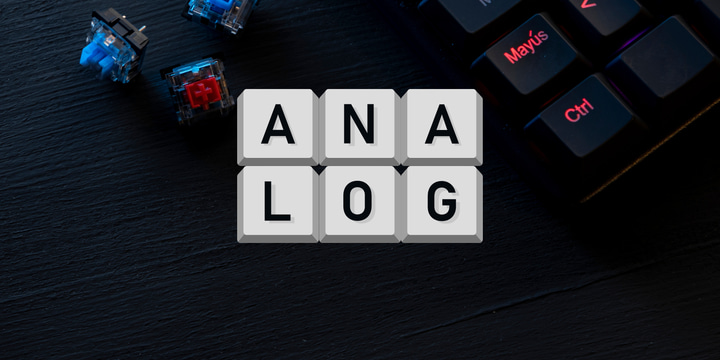
If you’re even a little bit into gaming keyboards, you’ll know that mechanical switches are the name of the game. There’s an extremely wide range of them out there (different keyboard switches explained) and for many years, traditional mech switches have been the standard in gaming and enthusiast keyboards for their performance and overall ingame feeling. Until analog switches came along, that is.
Analog switches are a relatively new addition to the keyboard market, and they are a true game changer. In this article, we’ll go over why that is and how analog switches work.
Traditional Mechanical Switches
In order to understand why analog switches offer such an advantage, it’s important to know how a traditional mechanical switch works.
A mechanical switch is made up out of different parts; housing, spring, stem, and a contact. Once the switch gets pressed down deep enough, the conductive leaf inside of the switch makes contact, thus sending a signal to your PC.
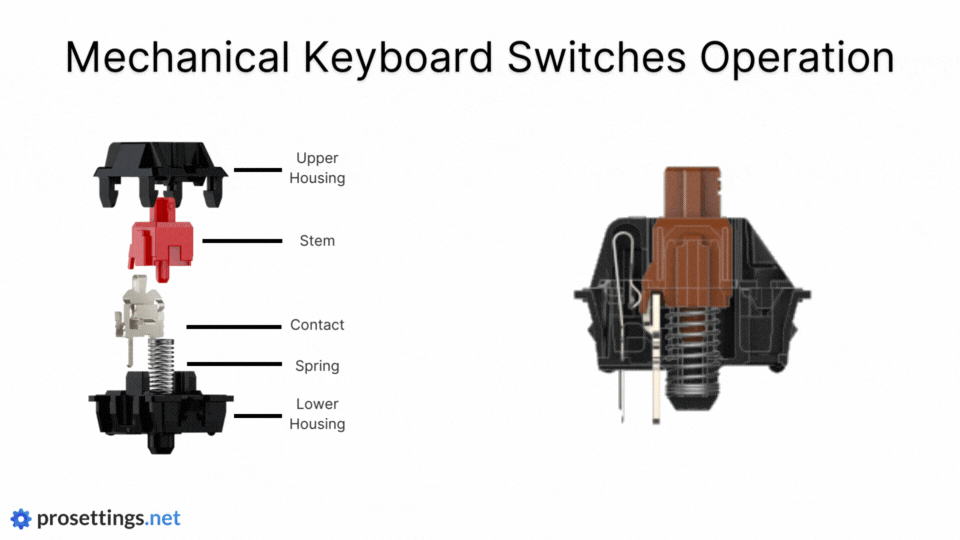
The point where a mech switch sends this signal is called the actuation point. This is typically between 1-3 millimeters, and it can vary between different switch types. The lower this actuation point, the faster and more sensitive a switch feels. Speed-oriented switches, for example, usually have an actuation point around 1mm.
Note that a key switch also travels beyond the actuation point. The distance that a switch can travel before bottoming out completely is the total travel distance.
To top it off, manufacturers can also use a variety of different springs. A heavier spring will require more force to push the switch, thus making the actuation force higher.
All of these customizable factors combined lead to an absolutely massive variety of switches. Companies experiment with different housing materials, actuation points, materials, springs, … There are quite literally hundreds of different switches on the market, ranging from mass-produced and commonly available switches to boutique, hand-lubed switches that can only be bought in enthusiast stores. No matter what your preferences are, there’ll probably be a switch for you out there.
Mechanical Switches For Gaming
Despite the incredible breadth of options out there, mechanical switches have a number of slight drawbacks for gaming when compared to optical switches.
Actuation
If you choose a switch to play with, its actuation point is set. There is no way to change the actuation point of a switch. If you want (for example) your WASD keys to be more sensitive than your other keys, you’ll need to purchase different switches in order to achieve this.
Travel
Mechanical switches have a set actuation point, meaning that you have to have to let your switch reset to a certain point if you want to actuate it again.
As an example, we’ll take a switch with a total travel of 4mm and an actuation point of 2mm. These are fairly common values for mechanical switches. If you actuate this switch and then bottom out, you have to let the switch travel back up to the reset point (which is typically a little bit above the actuation point) in order to use it again. The switch will also remain actuated while traveling up towards that reset point. On our example switch, this would be ~2.2mm of travel.
This might not sound like much, but in games where precision of movement is key (think of counter-strafing in CS2, or intense duels in Fortnite) this can make a difference.
Analog Keyboard Switches
Analog keyboard switches do away with the mechanical contact point entirely, and thus solve a lot of the issues outlined above. The most used analog switch right now is the Hall Effect (HE) switch.
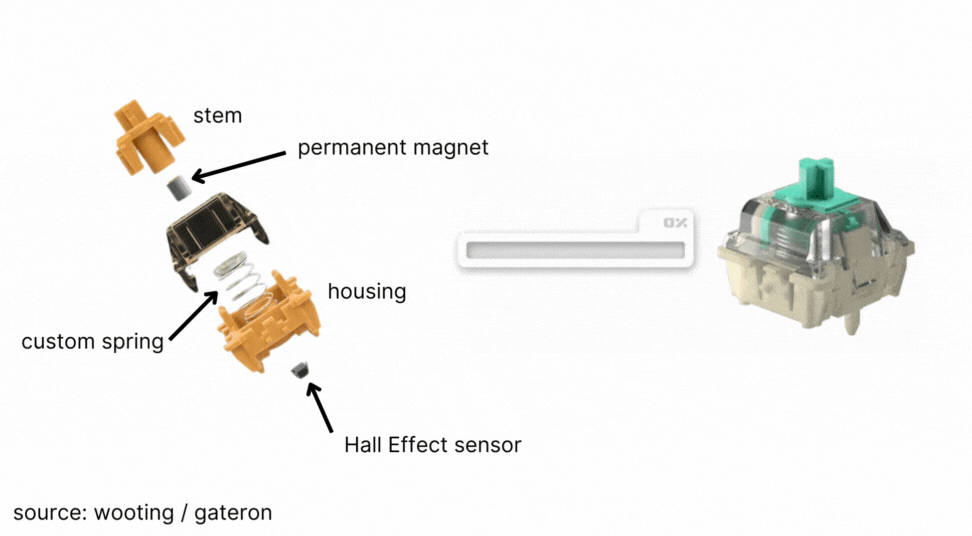
A Hall Sensor detects the presence and magnitude of a magnetic field, and its output voltage is directly proportional to the strength of the magnetic field through it. Thus, an HE switch knows how far a switch has been pressed at all times since the permanent magnet underneath the stem influences the output voltage. For the purposes of this article (which mainly talks about the advantages of analog vs mechanical switches) we’ll stick to this very basic explanation.
HE switches aren’t the only analog switches out there. Other technologies use light, for example. There, the switch knows the exact position of a key based on how much light is coming through.
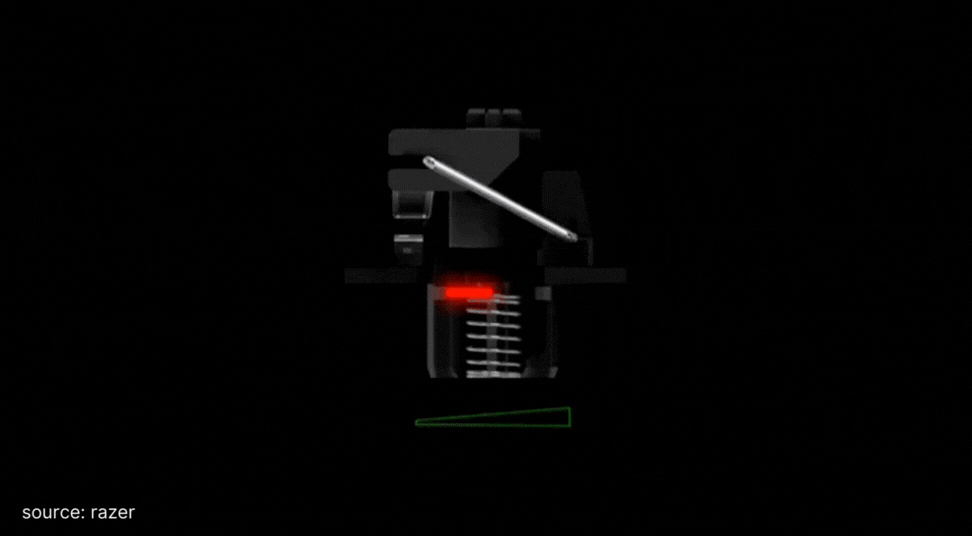
In short: an analog switch does not need a mechanical contact point in order to actuate. The switch can sense and detect movement across its entire travel distance. A mechanical switch only has one single point of detection: it’s actuation point.
Analog Switches For Gaming
The fact that analog switches can sense the position of a switch over the entire travel distance means that they can do things that are impossible for traditional mechanical switches.
Bear in mind that not every keyboard will have the same implementation. Not all keyboards with analog switches will allow for joystick-style movement, for example.
Customizing Actuation
The most obvious advantage of analog switches is that you can customize the actuation point. Most (but not all) analog boards allow you to change the actuation point of each individual key. This means that you can, for example, set your movement keys to be a lot more sensitive than keys bound to your ultimate ability. This drastically reduces the odds of fat-fingering one of those all-important keys. No more accidental reloads in firefights.
Beyond that, it’s also possible to change the actuation point depending on what you’re using the board for. You might want to have really sensitive keys when you’re playing a certain game and really heavy keys when you’re typing, or vice versa. All of this is possible with analog switches.
Rapid Trigger
This is a feature that was made popular by Wooting and has now been adopted (name and all) by the entire industry. Rapid Trigger is perhaps the most advantageous aspect of analog switches, as it allows your switch to reset at the time you let it go.
With a traditional mechanical switch, you have to wait until the switch has traveled beyond the reset point until you can press it again. As mentioned earlier in the article, this can take over 2mm of travel. While that doesn’t seem like much, it can be a big distance if you’re jiggle peeking a corner or doing stutters when in a firefight. Things like counter-strafing are also made to feel a lot more natural and responsive with a rapid trigger keyboard.
The ability to have the key instantly reset itself the moment you let it go quite simply makes movement and other precision-based ingame actions feel a lot smoother and more consistent. This difference can very clearly be felt if you ask us.
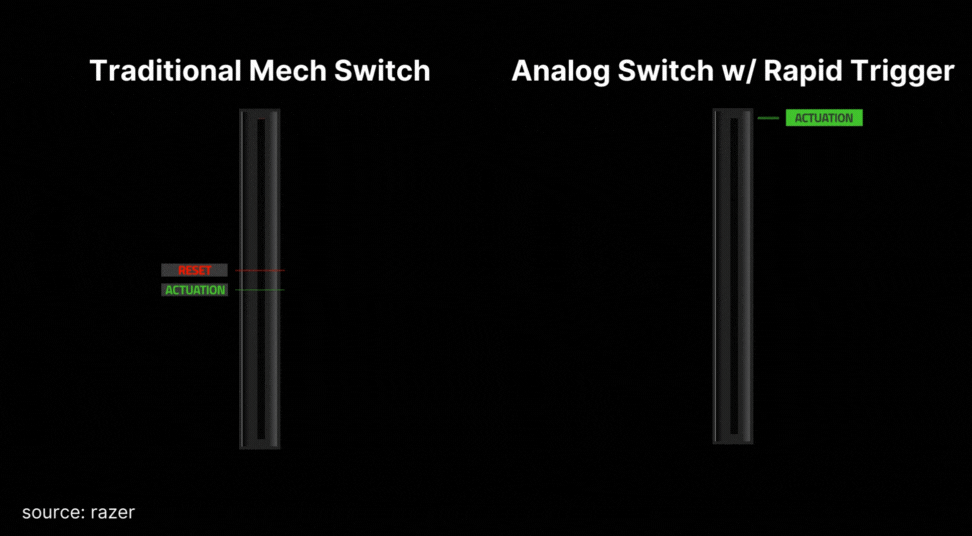
Analog Input
A traditional mechanical switch is either 1 (active) or 0 (inactive) with nothing in between. This is okay for some gaming genres, but things like racing games (for example) are rather annoying to play with a keyboard due to this. When racing with a mech keyboard, you’re either full throttle (1) or your ingame foot isn’t even on the gas at all (0). It’s the same for steering: you’re either fully going left (1) or you’re not going left at all (0).
Using analog inputs quite simply allows you to have a greater degree of control. An easy comparison is the joystick (which is an analog joystick) on a typical console controller. This allows for much greater input precision than simply using the arrow keys.
Multiple Inputs On One Key
Something you can also do with an analog keyboard is bind multiple inputs to one key. You could, for example, configure your character to run if you’ve got a key pressed halfway, and then have him sprint when you have it pressed all the way.
Durability
Traditional mechanical switches are already extremely durable, but analog switches are generally rated to last even longer. That’s because there are no contact points that can wear out over time. We wouldn’t necessarily say that this is a huge factor though, seeing how durable mechanical switches are.
Conclusion – Analog Keyboard Switches
In an industry that’s rife with gimmicks it can be hard to see when a new tech is actually a game changer. Analog keyboard switches are, without a doubt, the way forward for gaming keyboards though. They offer a number of unbeatable advantages over traditional mechanical keyboards that cannot be ignored.
Does that mean that traditional mechanical boards are suddenly bad? Of course not. Gamers at the highest levels have been using those for many years. A lot of pro players are still using traditional mechanical keyboards, though it has to be said that we’re definitely seeing a migration towards analog boards in general.
As with any gaming tech, it’s important to note that switching to an analog board won’t make you a movement God or anything like that though. There are objective advantages to using analog switches, but most of what makes a player good comes from the player, not the gear.
With that said: it’s no surprise that all big manufacturers seem to be pivoting towards analog keyboards. They are not a gimmick. They make you more consistent and feel more natural to use in a lot of games. They are here to stay if you ask us.


